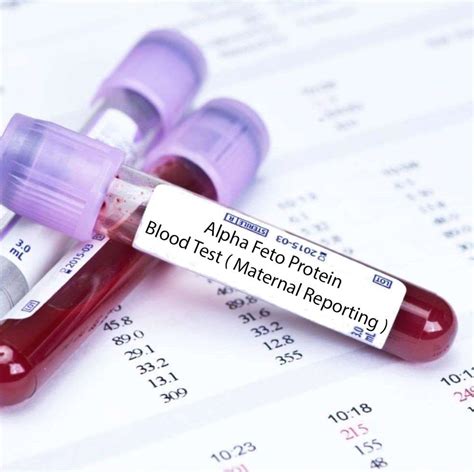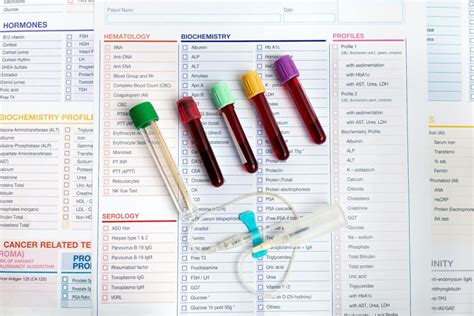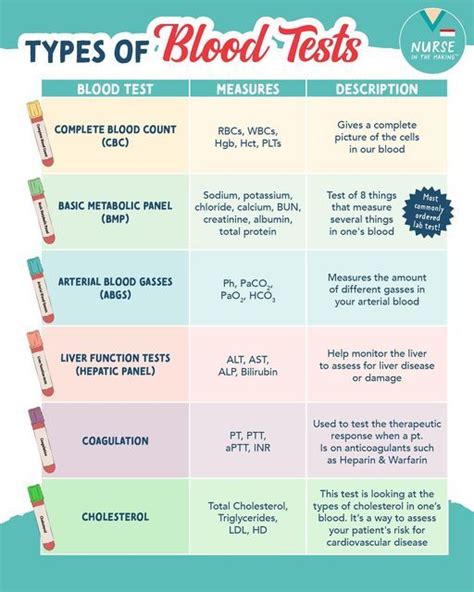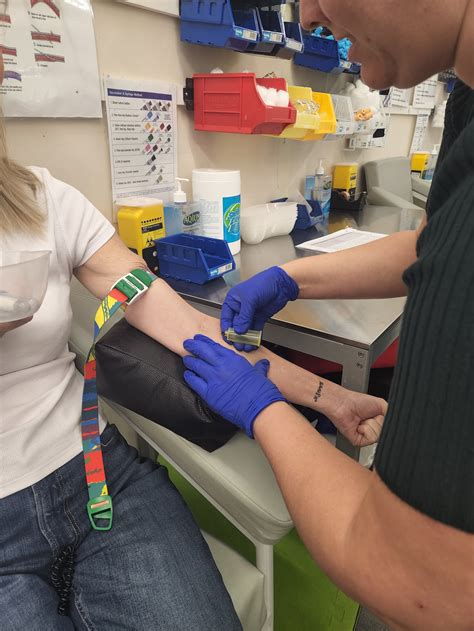Intro
Deciphering blood test results made easy. Understand lab values, normal ranges, and abnormal signs with our guide, covering complete blood count, blood chemistry, and more diagnostic tests for accurate health insights.
Understanding blood test results can be a daunting task, especially for those who are not familiar with medical terminology. However, it is essential to comprehend the information provided by these tests to make informed decisions about one's health. Blood tests are a crucial diagnostic tool used by healthcare professionals to assess various aspects of a person's health, from detecting infections and diseases to monitoring the effectiveness of treatments. In this article, we will delve into the world of blood tests, exploring their significance, the different types of tests, and how to interpret the results.
The importance of blood tests cannot be overstated. They provide valuable insights into the body's internal workings, allowing healthcare professionals to identify potential health issues before they become severe. By analyzing the components of blood, such as red and white blood cells, platelets, and various chemicals, healthcare providers can diagnose a wide range of conditions, including anemia, infections, and organ dysfunction. Moreover, blood tests can help monitor chronic conditions, such as diabetes and high blood pressure, ensuring that treatment plans are effective and making adjustments as needed.
Blood tests are a routine part of medical care, and their applications continue to expand as medical technology advances. From screening for genetic disorders to monitoring the progression of diseases, the role of blood tests in healthcare is multifaceted. As patients, understanding what blood tests reveal and how to interpret the results empowers individuals to take a more active role in their health management. This knowledge can reduce anxiety and uncertainty, enabling patients to engage more effectively with their healthcare providers and make informed decisions about their care.
Introduction to Blood Tests

Types of Blood Tests
There are numerous types of blood tests, each designed to assess different aspects of health. Some of the most common types include: - Complete Blood Count (CBC): Measures the levels of different components of the blood, including red and white blood cells and platelets. - Blood Chemistry Tests: Evaluate the levels of various substances in the blood, such as glucose, electrolytes, and enzymes, to assess organ function and detect diseases. - Blood Clotting Tests: Determine how well the blood can clot, which is crucial for preventing excessive bleeding. - Infectious Disease Tests: Detect the presence of infectious agents, such as bacteria, viruses, or parasites, in the blood.Understanding Blood Test Results

Key Components of Blood Test Results
When reviewing blood test results, several components are crucial to understand: - **White Blood Cell Count (WBC):** Indicates the body's immune response and can be elevated in the presence of infection or inflammation. - **Red Blood Cell Count (RBC):** Helps diagnose conditions such as anemia, which is characterized by low red blood cell count or hemoglobin level. - **Hemoglobin (Hb) and Hematocrit (Hct):** Important for assessing the severity of anemia and the body's ability to transport oxygen. - **Platelet Count:** Essential for evaluating the risk of bleeding or clotting disorders.Common Blood Tests and Their Significance

Interpreting Abnormal Results
Abnormal blood test results can indicate a variety of health issues, ranging from mild conditions to serious diseases. It's crucial to discuss any abnormal results with a healthcare provider, as they can provide context and recommend further testing or treatment as necessary. In some cases, abnormal results may require immediate attention, such as significantly elevated glucose levels in diabetic patients or critically low platelet counts that increase the risk of bleeding.Preparing for a Blood Test

What to Expect During a Blood Test
The process of undergoing a blood test is generally quick and straightforward. A healthcare professional will: 1. Clean the area where the blood will be drawn with an antiseptic. 2. Use a tourniquet to help locate a vein. 3. Insert a needle into the vein to collect the blood sample. 4. Remove the needle and apply pressure to the area to stop any bleeding. 5. Label the blood sample and send it to a laboratory for analysis.After the Blood Test

Monitoring and Follow-Up
For individuals with chronic conditions or those who require regular monitoring, follow-up blood tests may be necessary to assess the effectiveness of treatment plans or to detect any changes in health status. Regular communication with a healthcare provider is key to managing health effectively and making informed decisions based on blood test results.Conclusion and Next Steps

As you reflect on the information presented in this article, consider how you can apply this knowledge to your own health journey. If you have questions or concerns about blood tests or your health in general, do not hesitate to reach out to a healthcare professional. They are there to guide you, provide clarity, and support you in achieving your health goals.
What is the purpose of a blood test?
+Blood tests are used to assess various aspects of health, including detecting diseases, monitoring chronic conditions, and evaluating the effectiveness of treatments.
How do I prepare for a blood test?
+To prepare for a blood test, you may need to fast for a specified period, avoid certain medications or supplements, stay hydrated, and inform your healthcare provider about any health conditions or medications you are taking.
What do abnormal blood test results mean?
+Abnormal blood test results can indicate a variety of health issues. It's essential to discuss any abnormal results with a healthcare provider, as they can provide context, recommend further testing if necessary, and develop a treatment plan based on the findings.
We invite you to share your thoughts, questions, or experiences related to blood tests and health management in the comments below. Your engagement and feedback are invaluable, helping us tailor our content to better serve your needs and interests. By sharing this article with others, you can also help spread awareness about the importance of understanding blood test results and empower more individuals to take an active role in their health care. Thank you for reading, and we look forward to your contributions to this discussion.
